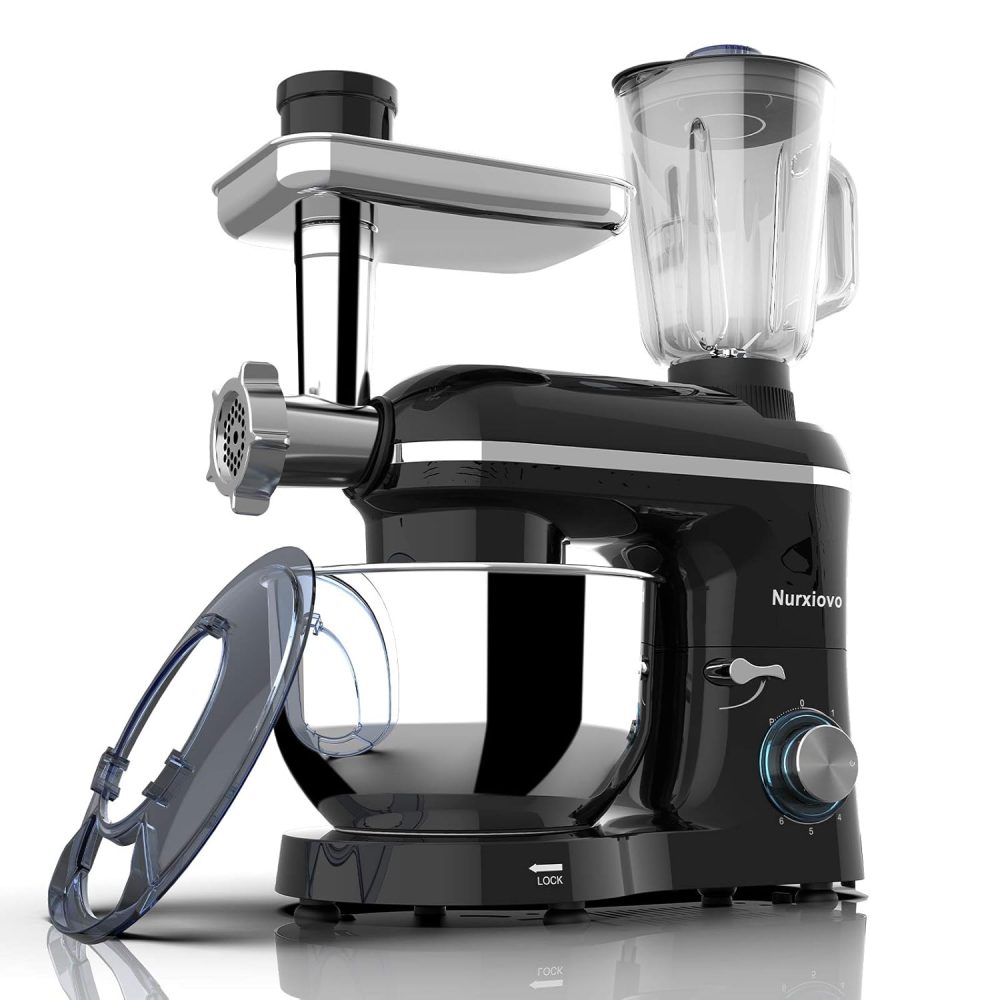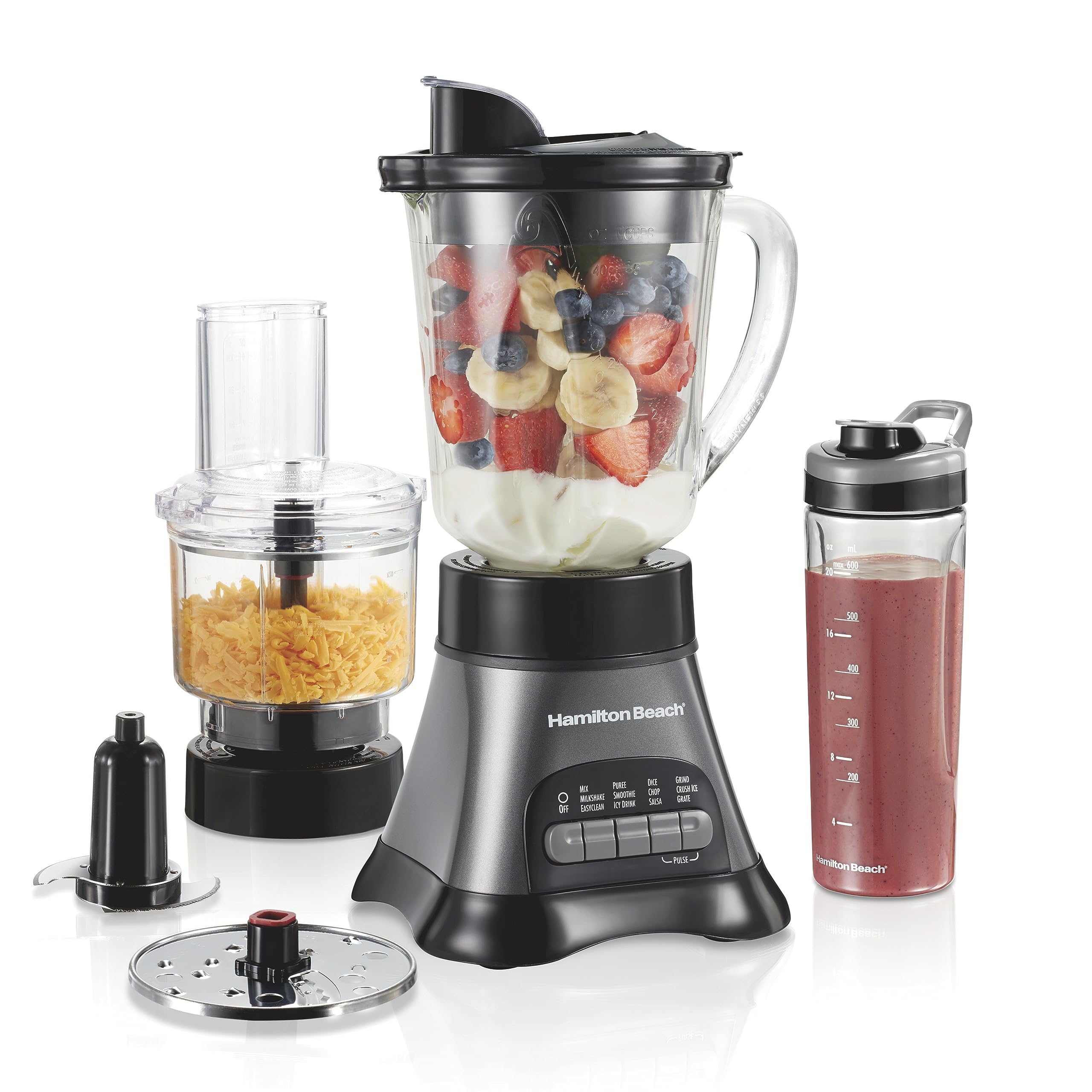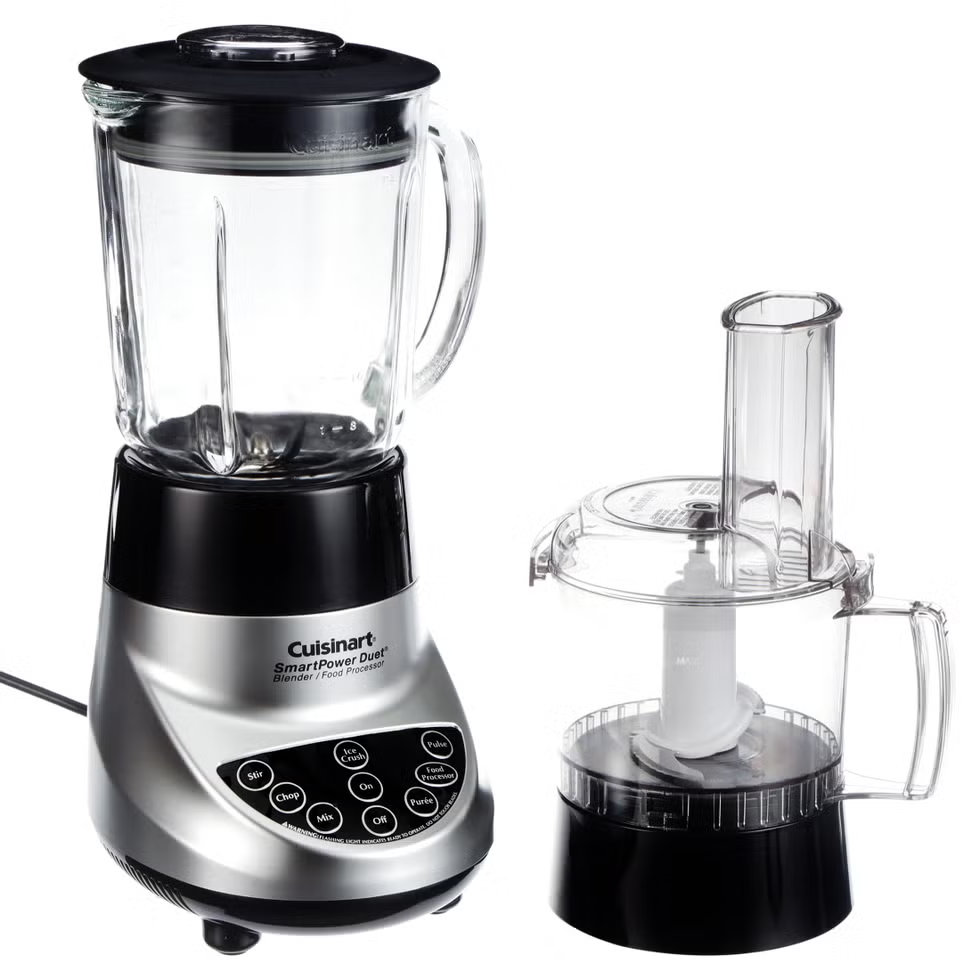
Introduction to Blender Food Processors
In the modern kitchen, efficiency and versatility are paramount, and the blender food processor stands out as an indispensable tool that combines the functionalities of both appliances. This hybrid device not only blends ingredients to perfection but also handles chopping, slicing, grating, and more, making it a versatile addition to any culinary space. Whether you’re a professional chef or a home cook, understanding the features, benefits, and uses of a blender food processor can significantly enhance your cooking experience and streamline your meal preparation process.
Understanding the Components of a Blender Food Processor
Blending Jar
The blending jar is a fundamental component of the blender food processor, designed to handle tasks that require smooth, consistent textures. Typically made from durable materials like glass or BPA-free plastic, blending jars come in various sizes to accommodate different quantities of ingredients. They often feature measurement markings, making it easier to follow recipes accurately.
Food Processor Bowl
Complementing the blending jar is the food processor bowl, which is adept at handling more substantial tasks such as chopping vegetables, kneading dough, and shredding cheese. These bowls are usually equipped with multiple blades and attachments, allowing for a range of culinary operations. The robust construction ensures that they can withstand the rigors of daily use without compromising performance.
Motor Base
The motor base serves as the heart of the blender food processor, providing the necessary power to drive both blending and processing tasks. High-performance motors, often rated between 600 to 1200 watts, ensure that the appliance can handle a variety of ingredients with ease. Advanced motor bases also come with multiple speed settings and pulse functions, giving users precise control over the texture and consistency of their preparations.
Control Panel
Modern blender food processors feature intuitive control panels that offer a user-friendly interface. These panels typically include buttons for different functions, speed adjustments, and sometimes even digital displays that provide real-time feedback on settings. Some models also offer preset programs for common tasks, simplifying the operation for users who may not be as comfortable with manual adjustments.
Key Features to Consider When Choosing a Blender Food Processor
Capacity and Size
When selecting a blender food processor, it’s essential to consider the capacity and size that best suits your needs. Smaller models with compact designs are ideal for limited kitchen spaces and quick tasks, while larger units are better suited for handling bigger quantities and more complex recipes. Assessing your typical usage can help determine the appropriate size and capacity for your household.
Power and Performance
The power of the motor directly impacts the performance of the blender food processor. Higher wattage motors can handle tougher ingredients like nuts, ice, and fibrous vegetables with ease, providing smooth and consistent results. It’s important to match the motor power with your intended use to ensure that the appliance meets your culinary demands without overheating or stalling.
Multi-functionality
One of the main advantages of a blender food processor is its multi-functionality. Look for models that offer a wide range of attachments and functions, such as chopping, slicing, shredding, blending, and pureeing. Some advanced models even include juicing and grinding capabilities, further expanding their utility in the kitchen.
Ease of Cleaning
A blender food processor with easily detachable parts and dishwasher-safe components can save a significant amount of time and effort in the kitchen. Removable blades, jars, and bowls that are simple to clean are highly desirable features, especially for those who use the appliance frequently.
Durability and Build Quality
Investing in a blender food processor with sturdy construction and high-quality materials ensures longevity and consistent performance. Stainless steel blades, reinforced jars, and robust motor bases are indicators of a durable appliance that can withstand regular use without degrading over time.
Safety Features
Safety should never be compromised in kitchen appliances. Look for blender food processors with built-in safety features such as locking mechanisms, overheat protection, and non-slip bases. These features prevent accidents and ensure safe operation, providing peace of mind during use.
Benefits of Using a Blender Food Processor
Time-Saving Convenience
A blender food processor consolidates multiple kitchen tasks into a single appliance, significantly reducing the time spent on meal preparation. From chopping vegetables to blending smoothies, the ability to perform various functions quickly enhances overall kitchen efficiency.
Versatility in Cooking
The wide range of functions offered by a blender food processor allows for greater creativity and versatility in cooking. Whether you’re making soups, sauces, doughs, or purees, having a single device that can handle multiple tasks expands your culinary repertoire and enables you to experiment with diverse recipes.
Improved Consistency and Texture
Achieving the perfect consistency and texture is crucial in many recipes, and a blender food processor excels in this area. With precise speed controls and powerful motors, these appliances ensure that ingredients are processed uniformly, resulting in smooth purees, finely chopped vegetables, and perfectly blended mixtures every time.
Enhanced Nutritional Value
Blending and processing ingredients can help retain more nutrients compared to traditional cooking methods. For instance, blending fruits and vegetables into smoothies ensures that you consume the entire produce, including fiber and vitamins that might be lost during cooking. Additionally, making your own sauces and dips allows you to control the ingredients, resulting in healthier options free from unwanted additives.
Cost-Effective Investment
Purchasing separate appliances for blending and food processing can be expensive and take up considerable kitchen space. A blender food processor combines these functionalities into one device, offering a cost-effective solution that saves both money and storage space without compromising on performance.
Popular Uses of Blender Food Processors
Making Smoothies and Shakes
Blender food processors excel in creating smooth and creamy beverages. Whether you’re blending fruits for a nutritious smoothie or mixing protein shakes for post-workout recovery, the powerful motor and efficient blades ensure a perfectly blended consistency every time.
Preparing Soups and Sauces
From creamy bisques to hearty marinara sauces, a blender food processor simplifies soup and sauce preparation. Its ability to puree ingredients seamlessly allows for smooth textures and consistent flavors, enhancing the overall quality of your dishes.
Chopping and Slicing Vegetables
Efficiently chopping and slicing vegetables can be time-consuming when done manually. A blender food processor equipped with the right attachments can quickly and uniformly chop onions, carrots, celery, and other vegetables, saving valuable time in meal prep.
Kneading Dough
Making homemade bread, pizza, or pastries requires well-kneaded dough. A blender food processor can take on this task effortlessly, mixing and kneading the dough to the perfect consistency without the need for extensive manual effort.
Grinding Nuts and Seeds
Creating your own nut butters or grinding seeds for baking becomes much easier with a blender food processor. Its powerful motor can break down nuts and seeds into smooth pastes or fine powders, providing fresh and customizable ingredients for your recipes.
Shredding and Grating
Shredding cheese, grating vegetables, or preparing toppings is a breeze with a blender food processor. The appropriate attachments allow for precise shredding and grating, ensuring uniformity and saving time compared to manual methods.
Maintenance and Care for Your Blender Food Processor
Regular Cleaning
To maintain the performance and longevity of your blender food processor, regular cleaning is essential. Immediately after use, disassemble the parts and rinse them thoroughly to prevent food residue from hardening. Most components are dishwasher-safe, but always refer to the manufacturer’s instructions to ensure proper cleaning practices.
Proper Storage
Storing your blender food processor correctly helps prevent damage and keeps it in good working condition. Ensure that blades are kept away from loose items or disposable kitchenware. Using protective covers or storing the appliance in a cabinet can help maintain its integrity and appearance.
Inspecting for Wear and Tear
Regularly inspect the appliance for signs of wear and tear, such as loose parts, damaged blades, or malfunctioning controls. Addressing these issues promptly by replacing parts or servicing the device can prevent more significant problems and extend the life of your blender food processor.
Lubrication of Moving Parts
Some blender food processors may require occasional lubrication of their moving parts to maintain smooth operation. Refer to the user manual for specific instructions on how to properly lubricate your appliance, ensuring that it continues to function efficiently.
Choosing the Right Blender Food Processor for Your Needs
Assessing Your Cooking Habits
Before purchasing a blender food processor, evaluate your cooking habits and determine which features are most important to you. If you frequently prepare smoothies and purees, prioritize models with powerful blending capabilities. Conversely, if you often cook with large batches or require extensive chopping and slicing, a food processor with a larger capacity and various attachments might be more suitable.
Reading Reviews and Ratings
Researching customer reviews and ratings can provide valuable insights into the performance and reliability of different blender food processors. Look for feedback on durability, ease of use, and customer service to make an informed decision based on real-world experiences.
Comparing Brands and Models
Different brands offer a variety of models with varying features and price points. Compare the specifications, warranties, and included accessories of multiple blender food processors to find one that best fits your budget and culinary requirements. Renowned brands often provide better quality and customer support, but lesser-known brands can also offer excellent value for money.
Budget Considerations
Blender food processors come in a wide price range, from affordable basic models to high-end units with advanced features. Determine your budget beforehand and look for a model that offers the best balance of functionality, quality, and cost. Investing in a mid-range model can provide most of the essential features without breaking the bank.
Warranty and Customer Support
A robust warranty and responsive customer support are indicators of a trustworthy blender food processor. Ensure that the manufacturer offers a reasonable warranty period and accessible support in case you encounter any issues. This can provide peace of mind and protect your investment in the long run.
Innovative Technologies in Blender Food Processors
Smart Controls and Connectivity
Some modern blender food processors come equipped with smart controls and connectivity features, allowing users to manage their device through smartphone apps or voice commands. These innovations enhance user convenience, enabling remote operation and customizable settings for a more personalized experience.
Self-Cleaning Functions
Advanced models may include self-cleaning functions that simplify maintenance by automatically cleaning the jar and blades. This feature saves time and effort, ensuring that your blender food processor remains hygienic and ready for the next use without manual washing.
Noise Reduction Technology
Blender food processors with noise reduction technology operate more quietly, making them ideal for use in households where noise levels are a concern. These models often incorporate specialized motor designs and sound-dampening materials to minimize operational noise without compromising performance.
Energy Efficiency
Energy-efficient blender food processors are designed to consume less power while maintaining high performance. These appliances are beneficial for environmentally conscious consumers and can help reduce electricity bills over time.
Enhanced Safety Mechanisms
Innovative safety mechanisms, such as automatic shut-off sensors and secure locking systems, prevent accidents and ensure safe operation. These features are especially important in households with children or inexperienced users, providing an added layer of protection during use.
Troubleshooting Common Issues with Blender Food Processors
Appliance Not Turning On
If your blender food processor fails to turn on, first check that it is properly plugged into a functional power outlet. Inspect the power cord for any visible damage and ensure that the appliance is securely assembled. If the issue persists, consult the user manual or contact customer support for further assistance.
Inconsistent Performance
Inconsistent performance, such as uneven blending or chopping, may result from improperly assembled parts or dull blades. Ensure that all components are correctly fitted and that blades are sharp and free from obstructions. Regular maintenance and sharpening of blades can help maintain optimal performance.
Overheating
Overheating can occur if the appliance is used continuously for extended periods or if it is handling particularly tough ingredients. To prevent overheating, allow the blender food processor to cool down between uses and avoid overloading it with heavy or large quantities of ingredients.
Leaking Jars or Bowls
Leaks can result from improper assembly or damaged seals. Make sure that jars and bowls are securely attached and that gaskets or seals are intact and free from cracks. Replace any damaged components to prevent further leakage and maintain the appliance’s functionality.
Unusual Noises
Unusual noises, such as grinding or rattling, may indicate loose parts or internal damage. Stop using the appliance immediately and inspect it for any loose or broken components. Addressing the issue promptly can prevent further damage and ensure safe operation.
 Conclusion
Conclusion
A blender food processor is a versatile and essential tool that can transform your culinary endeavors by combining the functionalities of both blending and processing appliances. From preparing smooth beverages and creamy soups to chopping vegetables and kneading dough, this multifunctional device streamlines various kitchen tasks, saving time and enhancing the quality of your dishes. By understanding the key features, benefits, and proper maintenance practices, you can select the right blender food processor to meet your specific needs and enjoy a more efficient and enjoyable cooking experience. Investing in a high-quality blender food processor not only improves your kitchen’s functionality but also inspires creativity, allowing you to explore a wider array of recipes and techniques with ease.

